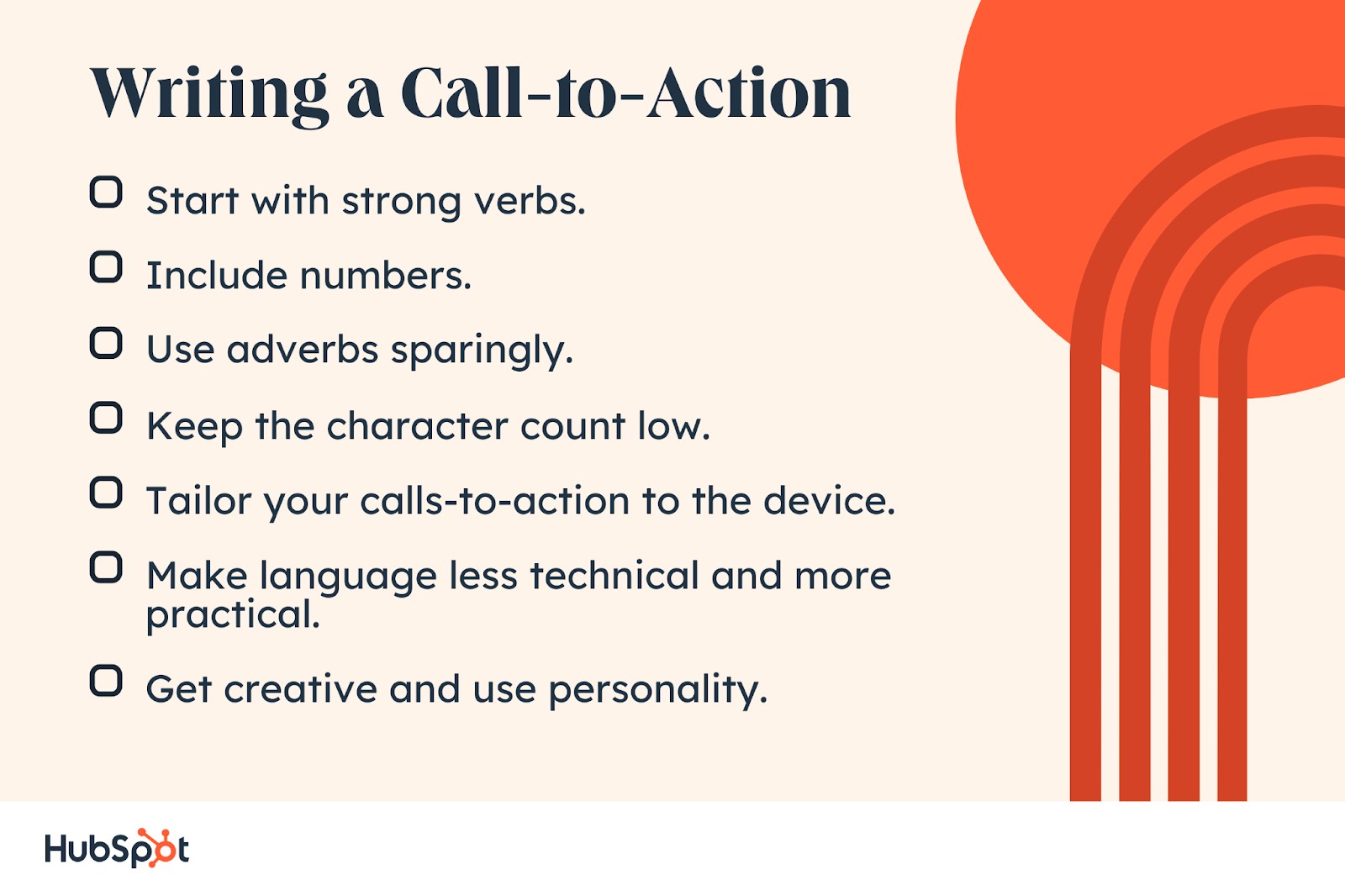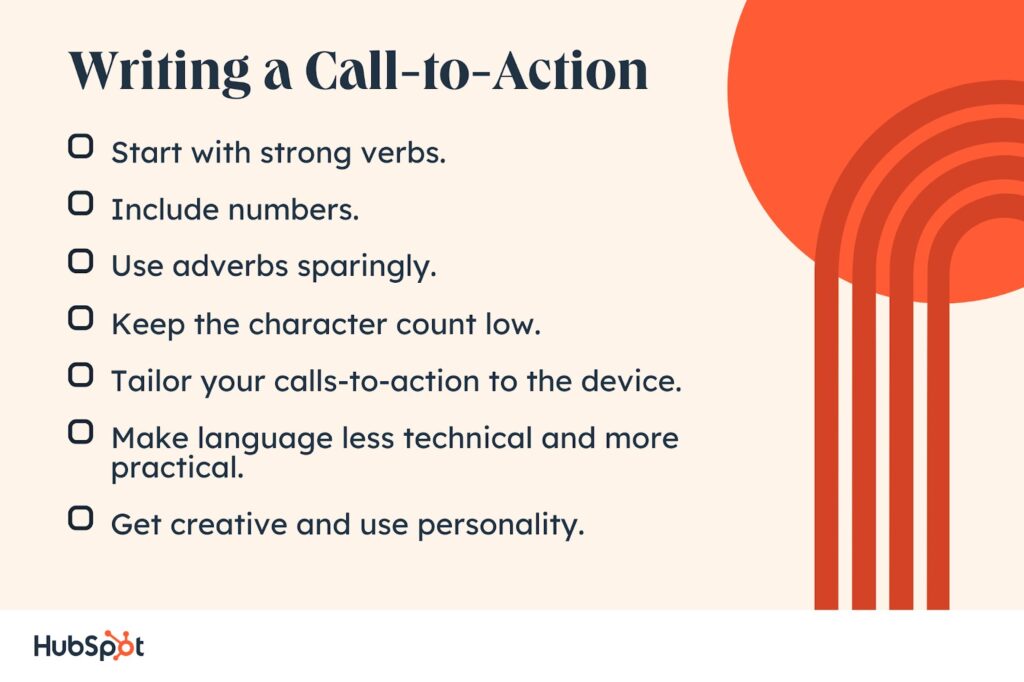Good writing matters in marketing. Being able to articulate ideas clearly is vital to capturing the attention of prospects. Let’s take a call-to-action (CTA) as an example.
If the copy you craft doesn’t draw visitors in, that can hurt your click-through rate, lead conversions, and sales.
In this blog post, we’ll discuss some vital copywriting lessons you should apply to your CTAs to drive traffic, generate more leads, and convert users into customers.
What is a call-to-action?
How to Write a Call-to-Action
What is a call-to-action?
A call-to-action (CTA) is a word or phrase that prompts a reader to take a desired action. In marketing, CTAs appear throughout campaign copy to convince your audience to take the next step down the sales funnel via a button or hyperlink.
Your CTA might prompt people to do one of the following actions:
- Subscribe to your email newsletter.
- Download an ebook.
- Sign up for an account.
If you want to convince more people to take the next step, your CTA must be compelling enough for them to click through. That’s why knowing how to write a CTA is essential.
How to Write a Call-to-Action
There’s a particular craft that goes into writing effective calls-to-action — it’s equal parts arts and science. Luckily for us, writing strong CTAs can be achieved with enough practice (or using a CTA tool to help you get started).
If you want to practice, follow these writing tips to craft strong CTAs that drive traffic and convert leads into customers.

1. Start with strong verbs.
The first piece of advice in the classic book Writing Tools encourages writers to start sentences with subjects and verbs. In English, we read from left to right, and verbs and subjects help us quickly glean a sentence's meaning.
As essential as these facts may be, acknowledging this when crafting your online CTA is crucial when readers' attention is more elusive than the shadow of a flapping bird.
Look at the example below from one of HubSpot’s landing pages. You’ll notice the first word at the beginning of each sentence is an action-oriented verb. Words like “drive,” “start,” and “create” get to the point and incite action that will immediately lead to a positive result.

By not including a verb in the CTA copy, you aren’t prompting readers to take action, which can hurt the click-through rate of your CTA and negatively impact conversions.
2. Include numbers.
The internet overflows with guesswork and vague statements. That’s why using data and numbers is a great way to demonstrate that your message is clear and straightforward.
Numbers are a great way to break through ambiguity, be specific about your offer, and set the right expectations. A number tells visitors exactly what they’ll get, how much of it, for how long, etc.
This technique has succeeded in calling-to-action copy and blog post titles, press release headlines, and email subject lines.
One study that analyzed 721 of the most popular articles on Medium found that the second most popular starting word is a number.
What numbers can you include in your CTA copy? You can add the page length of the whitepaper you offer, mention a specific discount, or list the numerical impact or benefit of a particular resource you provide.
For instance, HubSpot’s CTA for requesting a demo for our marketing product is, “See why over 177,000 customers use HubSpot to make marketing more human at scale.”
The number emphasizes how many people use and trust HubSpot for their marketing teams’ needs.

3. Use adverbs sparingly.
Most adverbs are recognizable by their “-ly” ending, e.g., “finally,” “unfortunately,” and “quietly.”
However, there are different types of adverbs (concerning direction, time, degree, and manner), and their function is to modify “constituents other than nouns.”
They have no fixed position in a sentence. For instance, you can place the word “finally” at the sentence's beginning, middle, or end.
Words like “really” or “incredibly” are often considered fluff and don’t add much value when a more powerful adverb could be in its place. For instance, “really hard” could replace “challenging.”
Limit the number of adverbs in your CTAs unless they add value to the sentence. The first word in this CTA on Zoom’s website is “securely,” which is a robust descriptor for its product.

4. Keep the character count low.
The standard advice for CTAs has been to keep them concise. Don’t write convoluted copy that will take your visitor long to read. (This also holds for other marketing activities, such as emails and press releases.)
In an analysis of high-converting CTA buttons, the study found that the average CTA included 3.411 words.

If you want to learn how to write a CTA that captures readers’ attention and gets to the point quickly, take a cue from how PR professionals write press release headlines.
Cision’s State of Press Releases Report found an average headline length of 88 characters.
Try to fit your CTA copy within these limits (or get some writing assistance to help craft concise messaging faster), and see how readers react. This also leads to the next point.
5. Tailor your calls-to-action to the device.
You should optimize everything from your website to the CTAs on your landing pages and emails for desktop and mobile users. This is especially true when mobile devices account for half of all web traffic worldwide.
If your users or audience primarily use their mobile devices to search for products or read their emails, optimize your CTA copy for a smaller screen.
A recent HubSpot survey of over 1,000 marketers found that 33% use mobile-friendly website design in their marketing strategy.
This shows that mobile users must be prioritized when assembling everything from your website to landing pages to CTA copy.
Put all of these CTA best practices into action to write more precise and concise prompts. Cut the fluff and use powerful action verbs at the beginning of your CTA so that mobile readers see the most important element first.
Also, consider writing shorter CTAs that won’t be at risk of getting cut off by limited screen space.
6. Make language less technical and more practical.
The language in your CTA will reflect industry-specific knowledge. However, some best practices hold for all CTA copies regardless of industry.
As with the other points we’ve examined, this one borrows from the best practices of different marketing activities.
Regarding headlines, words like “why” or “best” suggest the content can improve the reader. The same logic can apply to crafting CTA copy. Emphasize the offer's benefits and how it can make your prospects smarter.
In this CTA for the task management app Todoist, the headline is a simple sentence that expresses the reader’s desire to become more organized.
It strays away from using more complex words or phrases and offers a simple CTA of “Open Todoist.”

When writing your CTAs, stay away from overly technical jargon. Some of the words that attract the fewest views in blog posts include “franchise,” “investment,” “virtualization,” and “conferencing.”
These terms imply forced complexity and are less appealing to readers. If people don’t want to view content with such technical jargon, you should not include it in your CTA copy.
7. Get creative and use personality.
CTAs don’t have to be boring. You can craft a concise and compelling message by showcasing your brand’s personality or speaking in your audience’s language.
Take the CTA example below from the email brand Really Good Emails. Really Good Emails curates email marketing and design examples from around the web.
The brand shared a curated set of astrology-themed emails in a recent newsletter. The newsletter copy and the CTA aligned with the theme, which helped take their message even further.

Writing Excellent CTAs
Writing a call-to-action is excellent practice for crafting a clear and concise message.
If you want to drive more traffic, increase click-through rates, and convert more users, then knowing how to write a call-to-action is a skill all marketers must master.


